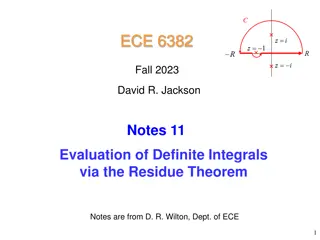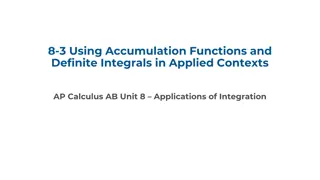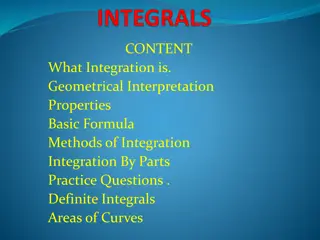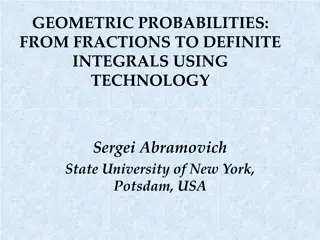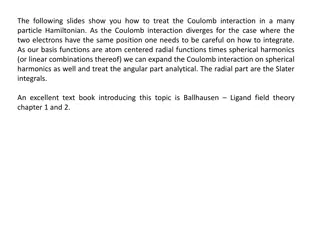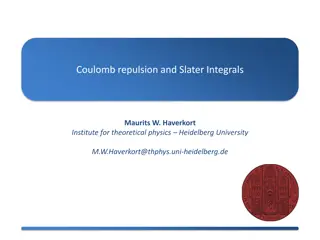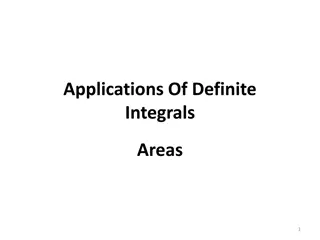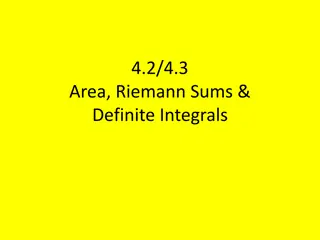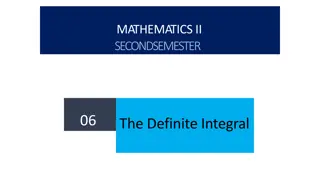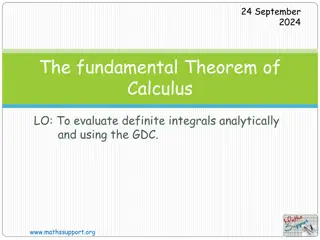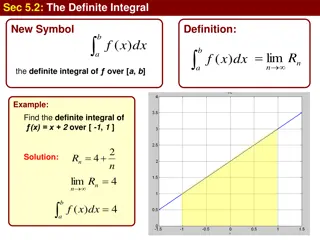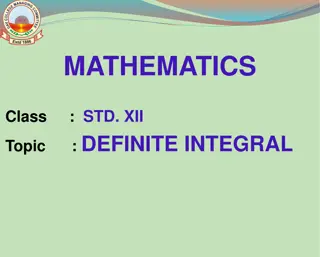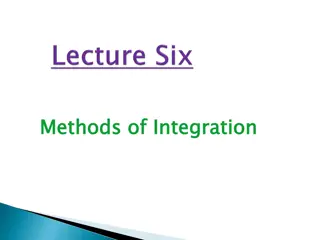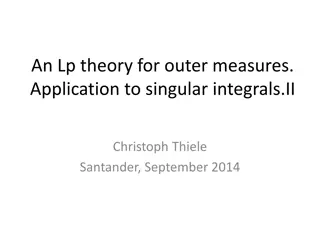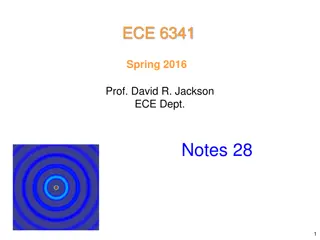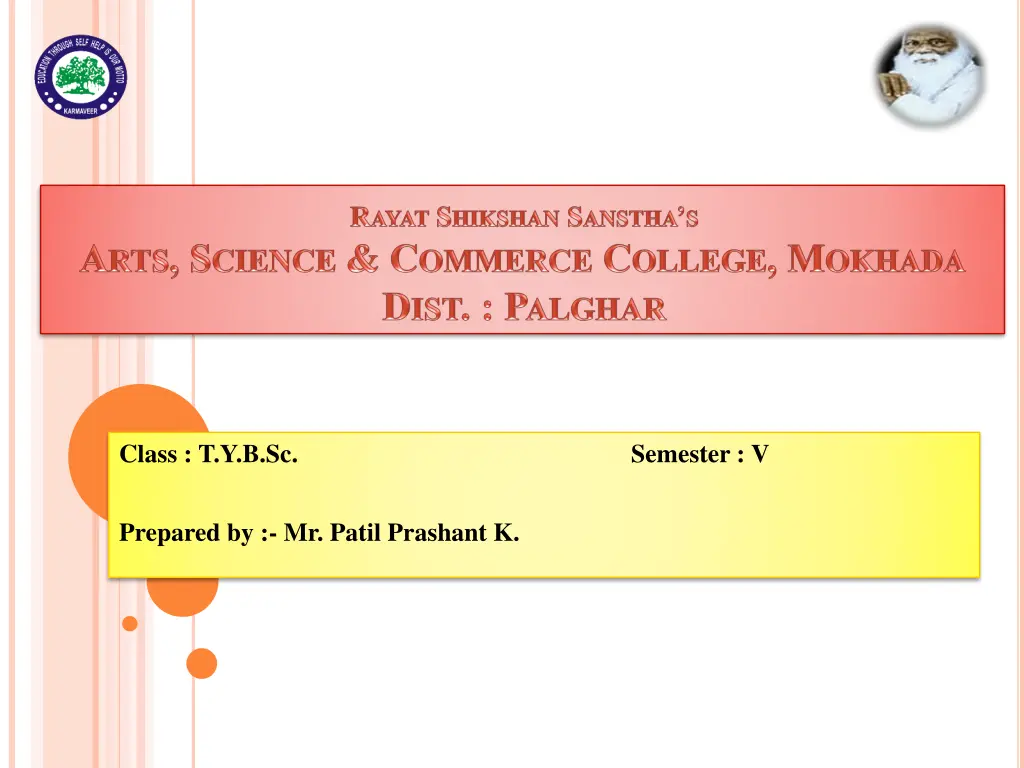
Understanding Multiple Integrals for T.Y.B.Sc. Students
Explore the concepts of multiple integrals in this chapter, extending from definite integrals to double and triple integrals of functions in two or three variables. Learn about volumes, masses of regions, using polar coordinates, and coordinate systems in three-dimensional space for simplifying triple integrals. Gain insights into the basics of definite integrals, Riemann sums, and applications in finding areas and volumes.
Download Presentation

Please find below an Image/Link to download the presentation.
The content on the website is provided AS IS for your information and personal use only. It may not be sold, licensed, or shared on other websites without obtaining consent from the author. If you encounter any issues during the download, it is possible that the publisher has removed the file from their server.
You are allowed to download the files provided on this website for personal or commercial use, subject to the condition that they are used lawfully. All files are the property of their respective owners.
The content on the website is provided AS IS for your information and personal use only. It may not be sold, licensed, or shared on other websites without obtaining consent from the author.
E N D
Presentation Transcript
Class : T.Y.B.Sc. Semester : V Prepared by :- Mr. Patil Prashant K.
INTRODUCTION In this chapter, we extend the idea of a definite integral to double and triple integrals of functions of two or three variables. These ideas are volumes, masses of more general regions. then used to compute
We will see that polar coordinates are useful in computing double integrals over some types of regions. Similarly, we will introduce two coordinate systems in three-dimensional space that will simplify computing of triple integrals over certain commonly occurring solid regions. Cylindrical coordinates Spherical coordinates
DEFINITE INTEGRALREVIEW First, let s recall the basic facts concerning definite integrals of functions of a single variable.
If f(x) is defined for a x b, we start by dividing the interval [a, b] into n subintervals [xi 1, xi] of equal width x = (b a)/n. We choose sample points xi*in these subintervals.
Then, we form the Riemann sum Then, we take the limit of such sums as n to obtain the definite integral of f from a to b:
In the special case where f(x) 0, the Riemann sum can be interpreted as the sum of the areas of the approximating rectangles.
Then, under the curve y = f(x) from a to b. represents the area
Double Integrals over Rectangles In this section, we will learn about: Double integrals and using them to find volumes.
As we attempt to solve the area problem, it led to the definition of a definite integral. Likewise, we now seek to find the volume of a solid. In of a double integral. the process, we arrive at the definition
DOUBLE INTEGRALS OVER RECTANGLES Rectangle Definition: Let R = {(x, y) 2 2/ a x b, c y d} = [a, b] x [c, d] x = a and x = b , y = c and y = d Y Y y = d y = c X X x = a x = b
Partition of a Rectangle: Let P1= {a = x0, x1, , xn= b} be a partition of [a, b] and P2= {c = y0, y1, , yt= d} be a partition of [c, d]. Let P = P1x P2= { (xi, yj) / 1 i n and 1 j t }, then P is called a Partition of the rectangle R. This Partition divides the rectangle R into nt subrectangles Rij= [xi-1, xi] x [yj-1, yj] = { (x, y) / xi-1, x xi, yj-1 y yj} where 1 i n, 1 j t Y Y y = d yt y2 y = c y1 x0 x1x2 xn X X x = a x = b
UPPER AND LOWER RIEMANN SUM Definition : Let f : [a, b]x[c, d] be a bounded function of two variables x and y defined over the rectangle [a, b]x[c, d]. Let P = P1x P2where P1= {a = x0, x1, , xn= b} P2= {c = y0, y1, , yt= d} dividing [a, b] x [c, d] into nt subrectangles Rij= [xi-1, xi] x [yj-1, yj] for i = 1, 2, ., n, and j = 1, 2, ., t Let mij= inf Mij= sup (x,y) Rijf(x,y) for i = 1, 2, ., n, and j = 1, 2, ., t Let Rij= Area of Rectangle Rij = (xi- xi-1)(yj- yj-1) Let L(P, f) = i=1 j=1 U(P, f) = i=1 j=1 Then L(P, f) is called Lower Riemann sum and U(P, f) is called Upper Riemann sum of the function f. f(x,y) (x,y) Rij t t n n mij Rij= i=1 Mij Rij= i=1 mij(xi- xi-1)(yj- yj-1) Mij(xi- xi-1)(yj- yj-1) j=1 j=1 t t n n
REMARK : n t n t Rij= i=1 (xi xi 1)(yj yj 1) i=1 j=1 j=1 n(xi xi 1) j=1 t = i=1 (yj yj 1) n(xi xi 1)[(y1 y0) + (y2 y1) +....+ (yt yt-1)] = i=1 n(xi xi 1)(yt y0) = i=1 n(xi xi 1)(d c) = i=1 n(xi xi 1) = (d c) i=1 = (d c)[(x1 x0) + (x2 x1) + + (xn xn-1)] = (d c)(xn x0) = (d c)(b a) = Area of Rectangle [a, b] x [c, d]
THEOREM Statement : Let R = [a, b] x [c, d] be rectangle. Let f be a bounded function defined on R. Let P be any partition of R. Let mij= (x,y) Rijf(x,y) and Mij= sup f(x,y), then inf (x,y) Rij m(b a)(d c) L(P, f) U(P, f) M(b a)(d c) Proof : Let P = P1x P2where P1= {a = x0, x1, , xn= b} P2= {c = y0, x1, , yt= d} dividing [a, b] x [c, d] into nt subrectangles Rij= [xi-1, xi] x [yj-1, yj] for i = 1, 2, ., n, and j = 1, 2, ., t Let mij= inf Mij= sup (x,y) Rijf(x,y) for i = 1, 2, ., n, and j = 1, 2, ., t f(x,y) (x,y) Rij
PROOF CONTINUED Clearly, m mij Mij M Where, m = inf (x,y) Rf(x,y) and M = sup (x,y) Rf(x,y) m(yj- yj-1) mij(yj- yj-1) Mij(yj- yj-1) M(yj- yj-1) ? ? ? m(yj yj 1) ?=1 mij(yj yj 1) ?=1 Mij(yj yj 1) ?=1 M(yj yj 1) t j=1 ? ? m(yt y0) ?=1 Mij(yj yj 1) M(yt y0) mij(yj yj 1) ?=1 ? ? m(d c) ?=1 Mij(yj yj 1) M(d c) mij(yj yj 1) ?=1 ? ? m(d c) i=1 n(xi xi 1) ?=1 Mij(xi xi 1)(yj yj 1) M(d c) i=1 mij(xi xi 1)(yj yj 1) ?=1 ? ? n(xi xi 1) ?=1 ?=1 m(d c)(xn x0) L(P, f) U(P, f) M(d c)(xn x0) m(d c)(b a) L(P, f) U(P, f) M(d c)(b a) Hence the proof.
DOUBLE INTEGRAL OF A BOUNDED FUNCTION OVER RECTANGLE Let f : [a, b]x[c, d] be a bounded functiondefined over the rectangle [a, b]x[c, d]. By previous theorem, for any partition P of [a, b]x[c, d], m(d c)(b a) L(P, f) U(P, f) M(d c)(b a) Thus, the set { L(P, f) / P is partition of [a, b]x[c, d] } is bounded above and has a supremum or l.u.b. And the set { U(P, f) / P is partition of [a, b]x[c, d] } is bounded below and has a infimum or g.l.b. Let L(f) = l.u.b { L(P, f) / P is partition of [a, b]x[c, d] } and U(f) = g.l.b { U(P, f) / P is partition of [a, b]x[c, d] }. Here, L(f) is called Lower Riemann integral and U(f) is called Upper Riemann integral of f. Then f is said to be Riemann integrable on [a, b]x[c, d] if L(f) = U(f) and equal to value of integral of f over [a, b]x[c, d] and is denoted by [a, b]x[c, d]? ?,? ??
PROPERTIES OF DOUBLE INTEGRALS Definition : A Partition P* of a rectangle [a, b]x[c, d] is said to be a refinement of the partition P if P P*. Theorem : Let f : [a, b]x[c, d] be a bounded function. Let P and P* be two partitions of [a, b]x[c, d] such that P P*, then i) L(P*, f) L(P, f) ii) U(P*, f) U(P, f)
RIEMANN CRITERIA FOR INTEGRABILITY Theorem : Let f : [a, b]x[c, d] be a bounded function, then f is integrable over the rectangle [a, b]x[c, d] if and only if for every > 0 there exist a partition P of [a, b]x[c, d] such that U(P, f) L(P, f) < .
VOLUMES In a similar manner, we consider a function f of two variables defined on a closed rectangle R = [a, b] x [c, d] = { (x, y) 2 | a x b, c y d } and we first suppose that f(x, y) 0. The graph of f is a surface with equation z = f(x, y).
VOLUMES Let S be the solid that lies above R and under the graph of f, that is, S = {(x, y, z) R3| 0 z f(x, y), (x, y) R} Our aim is to find the volume of S.
The first step is to divide the rectangle R into sub-rectangles. We divide the interval [a, b] into m subintervals [xi 1, xi] of equal width x = (b a)/m. Then, we divide [c, d] into n subintervals [yj 1, yj] of equal width y = (d c)/n. Next, we draw lines parallel to the coordinate axes through the endpoints of these subintervals. Thus, we form the subrectangles Rij= [xi 1, xi] x [yj 1, yj] = {(x, y) | xi 1 x xi, yj 1 y yj} each with area A = x y
Lets choose a sample point (xij*, yij*) in each Rij.
Then, we can approximate the part of S that lies above each Rijby a thin rectangular box (or column ) with: Base Rij Height f (xij*, yij*)
VOLUMES Compare the figure with the earlier one.
VOLUMES The volume of this box is the height of the box times the area of the base rectangle: f(xij*, yij*) A
VOLUMES We follow this procedure for all the rectangles and add the volumes of the corresponding boxes.
Thus, we get an approximation to the total volume of S:
VOLUMES This double sum means that: For each subrectangle, we evaluate f at the chosen point and multiply by the area of the subrectangle. Then, we add the results.
Equation 4 VOLUMES Our intuition tells us that the approximation given in Equation 3 becomes better as m and n become larger. So, we would expect that:
VOLUMES We use the expression in Equation 4 to define the volume of the solid S that lies under the graph of f and above the rectangle R. It can be shown that this definition is consistent with our formula for volume in Section 6.2
VOLUMES Limits of the type that appear in Equation 4 occur frequently not just in finding volumes but in a variety of other situations as well even when f is not a positive function. So, we make the following definition.
Definition 5 DOUBLE INTEGRAL The double integral of f over the rectangle R is: if this limit exists.


